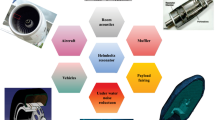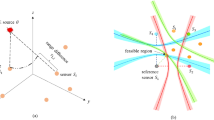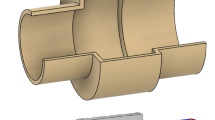Abstract
We investigate the influence of waveguides used in acoustic emission tests of materials in corrosive environments on changes in the parameters of acoustic emission (AE) signals. A method of boundary interpolation is suggested for determining the natural frequencies of the waveguides. This method enables one to perform calculations for cylindrical waveguides of various lengths and diameters. We present analytic relations used to select a waveguide with the required geometric parameters in agreement with the resonance bandwidth of an AE transducer. This selection reduces the losses of AE signals in passing through the waveguide. Experimental investigations of the attenuation of AE signals in the waveguide are also carried out.
Similar content being viewed by others

References
W. Nowacki,Theory of Elasticity [Russian translation], Mir, Moscow (1975).
A. S. Tripalin, V. M. Shikhman, and S. B. Karpenko, “Calculation of transducers made of texture piezomaterials and elastic waveguides,”Tekh. Diagnost. Nerazrush. Kontr., No. 3, 52–56 (1989).
E. V. Imenitova, V. V. Chernyshov, and V. V. Shegai, “Calculation of free vibrations of elastic cylinders of finite lengths,”Dokl. Akad. Nauk SSSR,226, No. 2, 315–317 (1976).
G. A. Komissarova, “An approach to the investigation of nonstationary vibrations of a cylinder of finite length,” in:Problems in Mathematical Physics and Oscillation Theory [in Russian], issue 3, Ivanovo (1975), pp. 96–102.
S. V. Veremeenko, “Calculation of the dispersion curves of axisymmetric and torsional vibrations in rods with free boundaries,”Defektoskopiya, No. 3, 55–58 (1967).
S. A. Fedorov and V. L. Tsvetyanskii, “Investigation of the excitation of ultrasonic pulses in elastic waveguides,”Defektoskopiya, No. 2, 90–96 (1981).
B. A. Kasatkin, “Calculation of the frequency of the principal mode of vibrations of circular plates and cylinders of arbitrary sizes,”Defektoskopiya, No. 12, 73–78 (1978).
V. V. Chernyshev and V. V. Shegai, “Natural vibrations of solid cylinders of finite lengths,”Akust. Zh.,23, No. 4, 627–631 (1977).
V. T. Grinchenko,Equilibrium and Stationary Vibrations of Elastic Bodies of Finite Sizes [in Russian], Naukova Dumka, Kiev (1978).
A. E. Andreikiv,Spatial Problems in the Theory of Cracks [in Russian], Naukova Dumka, Kiev (1982).
A. E. Andreikiv and N. V. Lysak,A Method of Acoustic Emission in the Investigation of Fracture Processes [in Russian], Naukova Dumka, Kiev (1989).
E. Kikuchi (editor),Ultrasonic Transducers [Russian translation], Mir, Moscow (1972).
V. A. Luk'yanenko and V. S. Grebennik, “Investigation of the acoustic channel of transducers with a rod waveguide for recording the acoustic emission of pipeline metal,”Defektoskopiya, No. 2, 87–89 (1985).
Additional information
Karpenko Physicomechanical Institute, Ukrainian Academy of Sciences, L'viv. Translated from Fiziko-Khimicheskaya Mekhanika Materialov, Vol. 30, No. 2, pp. 64–71, March–April, 1994.
Rights and permissions
About this article
Cite this article
Lysak, M.V., Skal's'kyi, V.R. & Sergienko, O.M. Investigation of the influence of a waveguide on changes in the parameters of acoustic emission signals. Mater Sci 30, 211–218 (1995). https://doi.org/10.1007/BF00558575
Received:
Issue Date:
DOI: https://doi.org/10.1007/BF00558575



